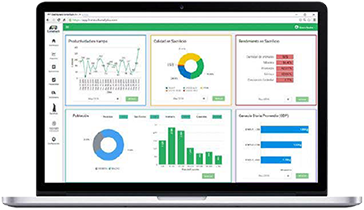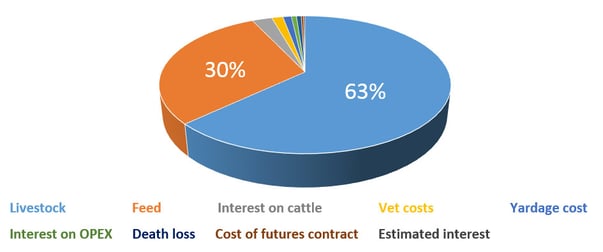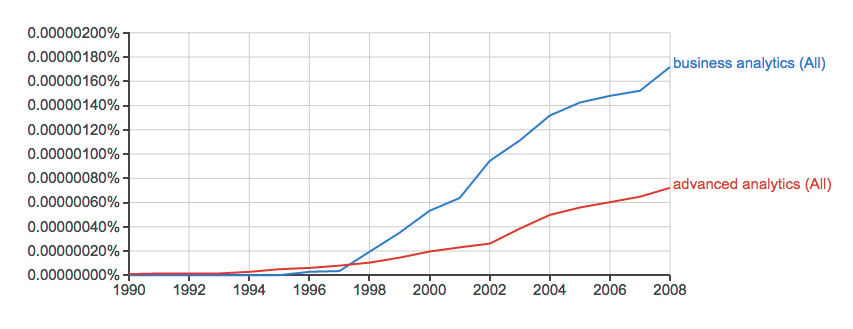Dear readers, this is the first post of this brand new blog hosted at Livestock Analytics. Here we’ll be sharing data and information, breakthroughs (and not so much ones), stories and learning lessons as we develop a system that helps you make better decisions by acquiring and analyzing individual data from your cattle.

Livestock Analytics Dashboard
INTRODUCING THE PROBLEM
Back in the beginning, one of the main drivers that got us working in this problem was a hypothesis we build from empirical data, which suggests that up to 80% of the farm-to-table cost happens within the feedlot. That is a lot. It means that no matter how large an improvement in latter processes (e.g. deboning, warehousing, logistics, commercialization, etc); the overall impact on the supply chain will be significantly less than compared with minor improvements within the feedlot.
Yes, the first problem here is this percentage is hard to estimate. First of all, because prices vary so much depending on so many factors. For example, let’s look at two of the main costs of growing livestock: cattle and feed (Oklahoma State University, 2014). Looking at corn (maize) in the past ten years we can see the price has gone from $94.36/metric-ton in February 2005, to a historic maximum of $332.95/metric-ton in July 2012, and back down to $173.70/metric-ton last month (Indexmundi, 2015). That’s a 36% average increase per year during the first 7 years, followed by a -16% average yearly decrease in the last 3 years.
On the other hand, livestock price variability isn’t much different. As you know, cattle prices depend on breed, age, sex, location, and weight, among other factors. Just to give an example based on feeder cattle at 500-550 lb steer prices in Oklahoma City reported by the USDA (USDA, 2015) show a 28.5% price increase in the last year between February 2014 and February 2015 (from $210.19/cwt to $270.00/cwt). Forget about a whole year, just within the past five months from October to February the price dropped -6.8%. Similar examples can be found in all reported prices whether steers or heifers, at 500 lb or 750 lb, in Oklahoma City, Sioux Falls, Texas or Nebraska.
But let’s step back for a minute and try to rationalize the process. Where in the meat production process is there a higher amount of value created? I think we would all agree it is when you actually purchase the cattle, grow it and slaughter it when it meets your standards. Specially because it happens for long periods of time usually ranging from 4-6 months during which your investment just ‘sits and feeds’. It only makes sense most of the cost will indeed happen in the ranch, perhaps even 80%.

Hence and beyond the fact that the actual cost percentage should be revised and perhaps studied, it is for certain that any effort to make more efficient the feedlot could have a higher impact in the whole meat production industry supply chain.
FOCUSING ON THE FEEDLOT
So the time came when we just knew we should focus on the feedlot and started analyzing what could we do to make it more efficient. That is, how can we make the feedlot get more out of the resources it has available. At this point we could’ve tried to industrialize the process, focus on labor or automation; but considering about 95% of the total cost of running a feedlot came from cattle, feed and veterinary costs (Oklahoma State University, 2014), it was clear these three were the objectives of this major effort to become a game changer for the industry.

So the obligated question became, how can we be more efficient in the process of using these three resources? In general, that meant, how could we purchase better resources, use them more efficiently and sell them with higher profit. This becomes increasingly important as we understand that the intensive feeding operation is as much a cattle management business as it is a financial one. Why? Well because if you were to start your own feedlot and wanted to slaughter 10 cattle per day after 100 days of feed, then you would have to buy inventory for 10 cattle per day times 100 days. That is, a 1,000 headcount operation. If your grown cattle costs about $2,000 per head, then you’ll be having an average investment of $2M that would ‘stand’ in your feedlot for 4 months plus selling lead time before you can receive a penny back.
So how could we make our feedlot more efficient? Well there are many ways to do so, just to name a few:
- Negotiate better purchase prices for all resources –e.g. cheaper cattle, cheaper feed and cheaper meds.
- Choose better cattle so we could maximize weight gain and maximize quality grades –e.g. more and better meat, hence more and higher-priced sales.
- Estimate head conversion at receipt for better planning –e.g. group similar cattle and provide specific diets.
- Design better diets so the interaction between cattle and feed rendered better results –i.e. higher average daily gain in our operation.
- Plan better strategies to optimize the growth process of cattle –e.g. use head-specific treatments and feeding days.
- Minimize disease outbreaks and mortality within the feedlot –e.g. identifying sick cattle faster and easier.
- And many more.
Ok. So now what? It certainly sounds easier than what it really is.
ADVANCED ANALYTICS FOR LIVESTOCK
Well it turns out other branches of science have been doing their own development of new tools and methods to analyze data. Now widely known as advanced analytics or business analytics, these tools/methods have been adopted by virtually all industries which now rely heavily on analytic tools to be more efficient and competitive:
- Supermarkets analyze all data from pricing effects on profit to customer behaviour.
- Logistics companies are improving day-to-day thanks to optimization and logistics modeling.
- Manufacturing operations use optimization and statistics in almost every aspect of their business.
- Financial markets have long used analytics tools to make decisions.
- Even human resources departments are now using analytics to understand better workers’ behavior.
- Both terms have become increasingly important in the past few years thanks to the easily and cheaply availability of data in many industries, as well as the increased capacity of computer power to analyze such data.

Still, the implementation of advanced analytics for the cattle feedlot industry turns out to be very limited. Even so more limited than other livestock operations as dairy farms or pork farms.
This is the gap Livestock Analytics will fill in –by providing an integrated system that help you make better decisions in your feedlot. To make better decisions you need two things, first you need data and we help you acquire individual data. Second, you need analytics and we provide you tools to analyze the data and make recommendations to make better decisions.
WHAT’S NEXT?
If you would like to stay tuned please subscribe to our newsletter. We will post as often as we can new information and improvements we release. It doesn’t cost anything to subscribe and it might help you in your business even if you are not a Livestock Analytics user. You can also browse our website for more information and contact us if have specific inquiries about our system. If you have any comments or questions please let us know below.
Tags:
February 7, 2023